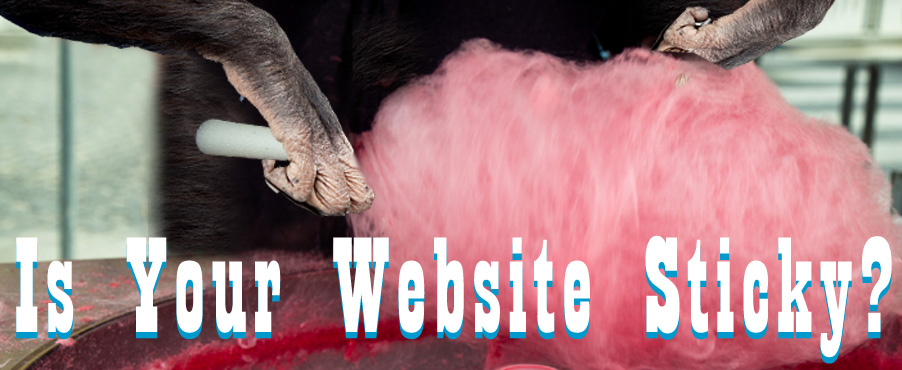
If you’re lucky, website visitors will give you 10 to 15 seconds to capture their attention before they move on to a shinier, more engaging web experience. As the marketing/sales leader for your organization, you need to be asking, “What are we doing on our website to capture hearts and minds in those precious few seconds we’ve been given to make an impression?”
You’ve probably heard the term “sticky” as it relates to websites and blogs. It’s apropos. For me, it’s always conjured images of fingertips gobbed with cotton candy or computer mice stuck to sheets of flypaper. You’re stuck, captured, unable to close that window and continue surfing along merrily. Now that’s the kind of content I want for my website, and for the websites of my clients!
So I ask, “Is Your Website Sticky?” Do you know how long visitors are staying there before moving on?
If not, most web analytics will tell you—from Google Analytics to even basic packages offered by many web hosts these days.
While the average time someone spends on your site isn’t as cut-and-dried a measure as you would expect—there are many dissenting “expert” opinions on how the time gets measured and how visits are counted (some studies suggest that more than half of visitors to all websites spend less than 15 seconds there)—the general rule of thumb is the longer someone spends and the more pages accessed, the more likely he or she is interested in what you have to say and what you have to sell. (More reading on this here and here.)
Couple the time spent on your web site with your conversion rate (the number of total website visitors vs. the number of people inquiring about or buying your product), and you’ll get an even better idea if your website is sticky in a way that’s connecting with your target audience. Thus, in the parlance of web analytics, a high average time spent on a website with a high conversion rate is a positive thing!
Making it Sticky
When it comes to making your website sticky, what’s important?
Here’s a preliminary list to get you started:
- Pleasing Design and Graphics
It’s almost cliché, but first impressions count. The way your website looks is the first thing that registers with website visitors. Are your graphics pleasing or do they annoy? Are they too much, or just enough? Are they modern or outdated? Do they speak to your target audience? Is the layout easy to navigate? Are fonts and styles easy to read?
- Compatibly/Accessibility
How does your website perform on major browsers? Does it operate great on Firefox, but fail on Chrome? Is your website mobile friendly, or is it designed for desktop visitors only? Numerous studies reveal that more than 60% of online access is via mobile devices . . . and with the number of smartphone and tablet users growing every day, that number is sure to continue growing. It’s 2016. It’s time to go mobile.
- Appeal to their Senses
Just as not everyone learns the same way in school (some are visually-oriented, while others prefer to read their information, for example), people have preferences for how they get their information online, too. Video is fast becoming the preferred method of content consumption (this from Zenithoptimedia.com, “Video consumption on mobile devices, such as smartphones and tablets, is forecast to grow by 43.9% in 2015 and 34.8% in 2016”) while others still prefer to “read” their content, and still others enjoy the merits of a good, old infographic. In the best of all worlds, your content delivery method would appeal to all types of content consumers, or at the very least to the way your target audience prefers to digest content.
- Be Provocative
While large images and dominant headlines grab attention, being provocative is what you need to pique the interest of your visitors. For example, while skimming the web the other day, I saw these headlines: “Why losing your job is the best thing for your career” and “Why you won’t finish this article.” Get the idea? You don’t need to be crass or over the top, but plain vanilla pictures and headlines just don’t sell. Spice it up a bit.
- Make it Valuable
Now that you’ve gotten the attention of your website visitor, you need to deliver content that’s of great value—something they can use, content they can’t get elsewhere and that they’ll want to share with others (such as news or insight from you as the expert).
Your content can include a blog, white paper, video, infographic, how-to article or video, or any combination thereof. Keep it simple, make it credible, and be engaging. When it comes to content, there’s value in providing value.
Purrr-fectly Sticky!
Most successful small businesses spend a lot of time and resources to get their business online, whether in the form of a website, a blog, social media, or all of the above.
To go the next step, to get the most bang for your buck, your website needs to capture the attention of visitors and then engage them in some form of interaction—whether it’s a phone inquiry, signing up for a mailing list, joining a forum, or buying/downloading a full-blown product or service.
Engagement comes from the stickiness of your website’s design and content. Make it sticky! Let there be cotton candy and flypaper all around!
12 Steps to a Better Web Development Experience
It may be easy to get online, but it’s not so easy to do it well. The Barrel O’Monkeyz “12 Steps to a Better Web Development Experience” White Paper (PDF format) is full of ideas and resources you can use right away to begin developing your web strategy. Click here to download.
Paul June is King Monkey of BARREL O’MONKEYZ, a full-service digital media and marketing group specializing in more creativity, ideas, and fun for action sports marketing, sportswear marketing, sports product marketing, active lifestyle consumer products, health product marketing, and brands in San Diego and Southern California.

Trackbacks/Pingbacks